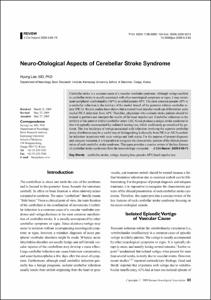Neuro-Otological Aspects of Cerebellar Stroke Syndrome
- Keimyung Author(s)
- Lee, Hyung
- Journal Title
- Journal of Clinical Neurology
- Issued Date
- 2009
- Volume
- 5
- Issue
- 2
- Abstract
- Cerebellar stroke is a common cause of a vascular vestibular syndrome. Although vertigo ascribed to cerebellar stroke is usually associated with other neurological symptoms or signs, it may mimic acute peripheral vestibulopathy (APV), so called pseudo-APV. The most common pseudo-APV is a cerebellar infarction in the territory of the medial branch of the posterior inferior cerebellar artery (PICA). Recent studies have shown that a normal head impulse result can differentiate acute medial PICA infarction from APV. Therefore, physicians who evaluate stroke patients should be trained to perform and interpret the results of the head impulse test. Cerebellar infarction in the territory of the anterior inferior cerebellar artery (AICA) can produce a unique stroke syndrome in that it is typically accompanied by unilateral hearing loss, which could easily go unnoticed by patients. The low incidence of vertigo associated with infarction involving the superior cerebellar artery distribution may be a useful way of distinguishing it clinically from PICA or AICA cerebellar infarction in patients with acute vertigo and limb ataxia. For the purpose of prompt diagnosis and adequate treatment, it is imperative to recognize the characteristic patterns of the clinical presentation of each cerebellar stroke syndrome. This paper provides a concise review of the key features of cerebellar stroke syndromes from the neuro-otology viewpoint.
- Keimyung Author(s)(Kor)
- 이형
- Publisher
- School of Medicine
- Citation
- Hyung Lee. (2009). Neuro-Otological Aspects of Cerebellar Stroke Syndrome. Journal of Clinical Neurology, 5(2), 65–73. doi: 10.3988/jcn.2009.5.2.65
- Type
- Article
- ISSN
- 1738-6586
- Appears in Collections:
- 3. Research Institutues (연구소) > Brain Research Institute (뇌연구소)
1. School of Medicine (의과대학) > Dept. of Neurology (신경과학)
- 파일 목록
-
-
Download
 oak-aaa-2763.pdf
기타 데이터 / 1.06 MB / Adobe PDF
oak-aaa-2763.pdf
기타 데이터 / 1.06 MB / Adobe PDF
-
Items in Repository are protected by copyright, with all rights reserved, unless otherwise indicated.